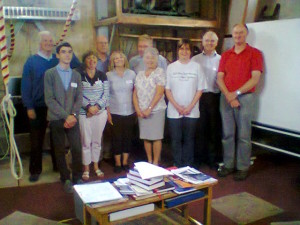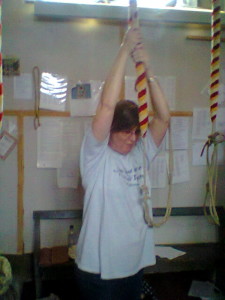History
A request by a Spanish youth came through ART Secretariat in February. Victor, a 15 year old pupil was keenly interested in full circle bell ringing and wished to learn to ring. Was there an intensive 2 or 3 day course available over the summer? David, SDGR Training Officer and keen to promote ITTS LtR scheme and the ART, was asked by Rose at ART if there was possibility of accommodating him. David contacted Richard Heath and a process of making a course possible was started. Accepting the challenge, David, as correspondent wrote to say that in principle the training would take place. Organisational mode was adopted by the two ART members, knowing how time consumes ideas with a vengeance. We had about four months before we needed to give potential learners the go ahead.
Policy
Any training program was to apply the LtR model. Major elements to consider were staff, location, date and other learners. Buried in these were holidays, church availability, access, food, and eligible staff bearing in mind an available, non-working population. There was a need to choose a location where public disturbance would not compromise the sessions. Edington Priory, with the simulator, was first choice if available. To achieve the objective staffing would need to come from the pool of ART and ITTS LtR training scheme ringers. More Learners would be needed to make a viable group to join Victor. Advertising through the Calne Branch Secretary joined that done by the Devizes Branch Secretary. Safety, cost, refreshments and practical timetabling were to be addressed.
Process
Victor was on board and with his parents was due in the Bradford on Avon area for their holiday late July / early August. There was no problem with the use of Edington Priory bells and their splendid kitchen facility. Indeed Edington Priory members were pleased that the centre and facilities could be used. August 3 / 4 was set for a two day course. The ART Secretary, Rose, had run a three day course but we felt three days too much to organise and contemplate on this first occasion.
A Scheme of Work for the course, to enable active teaching to the LtR objectives, was designed. Such a scheme document would assist teachers keep track of the learners and also aid hand-overs where teachers could not commit to all of the sessions planned. Aims and Objectives were straight forward as the ART had done all the hard work in their Level 1 and Level 2 of their five part scheme in their ‘Blue Book’.
The timetable called for three 2 hour sessions each of the two days with two one hour breaks between. The gathering decided that a Teacher per Learner would work best dealing with Teacher swaps as required. The early stages of ringing were dealt with corporately and the Learners were introduced to the bells and Andrew rang a bell up and down whilst the components of a bell, frame and process was talked about.
Results
The Learners placed much emphasis on breaking a stay as picked up as ‘street talk’. There was much concern and this somewhat coloured learner confidence in sessions. Though pointing out that stay breaking was unlikely and that the chances of injury were small [as indicated by the premiums insurance companies demand for ringing situations] the nervousness continued. Four learners joining Victor, now 16 years old, were of more senior years. One learner had been to many weekly simulator sessions over the previous 15 weeks or so. As an Edinger she had been given the basic message and some practice at strokes. A subsequent email confirmed that she found considerable difficulty in joining both strokes together.
Frustration in not progressing added to her lack of co-ordination and distress at not being able to be consistent in pull; hand movement on and off the rope; detecting where the bell was; or how much energy her lack of faith in the previous instruction and disappointment that the two day course hadn’t produced a good ringer! Tiredness didn’t help! Three other learners brought their own problems which had not occurred to some teachers nor been experienced before. One lady had a genuine fear of the rope ‘flashing past her face’ and required some quiet one to one conversation to allow progress. Even so an element of stress did result in releasing the rope and thus adding to the panic attack at seeing an uncontrolled rope close to her face. There was no physical harm done as the rope was speedily brought under Teacher control. Two others at the same ‘home’ tower progressed slowly, suffering mainly, as the other two, from fatigue, clearly attributed to ringing ‘processes’ employing previously unused muscles. Un-phased, Victor got into the co-relation between rope movement and bell action making sure he rang the bell and didn’t let the bell ring him thus dictating pace and energy input. Again, something a little lost on the other four and brought out by one lady saying, “not really what a man would understand – but not until my baby kicked did the word “pregnancy’ have meaning”.
Monitoring learner progress after the school will be difficult as two in one tower and a third have no ART / LtR ringer in their tower and the other two may suffer from lack of time on the rope. A program of monitoring by Teachers off this course has been enacted to ease the transition to home tower whilst maintaining the Learner’s ringing development. For Victor the challenge is matched by practical difficulty with his aspirations. He has his ITTS LtR Level 1 Certificate, well deserved, and all credit to David, his Teacher, for developing his attitude and aptitude to this level. He rang at two local towers during the week. Interest in Bells will not diminish and his ability to seek ringing training in UK bodes well for his progress.
Future
My hope was for all Learners to achieve at least Level 1 and go a long way toward Level 2 skill base. ‘Ambition knows no bounds’ – alongside pushing for more rather than limiting expectations from the start!
What would be done differently on another occasion? Use of the teaching materials helped and will be adjusted in terms of Teacher and Learner feedback from this first School. The sessions, for older Learners, were too long which is disappointing as more spread-out sessions require more resource commitment and more time in a particular learning centre. Teenage learners will cope with a tight timetable but all would benefit from more discussion time centred on visual materials between practical sessions. Such materials are to hand and as modern learning seems to take place via video screens their inclusion may be the way forward. Good benefit was gained by Andrew’s palmtop showing video of bell motion beside ringer actions on the bell’s rope. “What is happening to the bell as I am ‘operating’ the rope?” would be answered with a camera over a learner’s bell with a monitor in front of the learner whilst ringing. Use of a video camera would also help feedback if used to capture learner action during training. A Teacher per Learner was good in principle but more discussion / demonstration with two Teachers / Learners in certain stages and processes would help. Kinaesthetic and auditory alongside visual learning styles need perfecting. In-session use of the printed materials provided to support learning outcomes in the scheme of work was little used due to pressure of time. Time spent on that material would form useful non-physical learning sessions.
A plan for the future is to repeat the school but with different timing of length of sessions and possibly over two days further apart. ‘Aims and Objectives’ and ‘Teaching Scheme’ to be given out to Teachers well before the teaching start date. Five learners and five Teachers may be adequate if sufficient advanced notice is given and less physically demanding session times is planned. Separate schools for close age / aptitude groups are preferable for the future. More visual aids to be used: including video equipment for recorded and live materials. I would still be left with a feeling of putting on fellow ringers and some timidity in asking to get involved on such a scheme. As it stands I am grateful for the Teachers’ work and especial thanks to Andrew, Jane and Lin from Calne Branch for putting in so much time and effort when no Calne Branch area learners attended and to Patsy, Chris and Peter, of Devizes Branch.

Andrew Woolley, Charles Osborne, David Hacker, Elaine Nicholas, Felicity Whiffin, Lin Drummond-Harris, Maggie Tidcombe, Peter Baker, Richard Heath, Victor Perez Aldea
Summary
*Follow on sessions programmed in the Scheme.
*More breaks for discussion needed.
*Spread of age in the group distressed slower learners.
*Teacher per Learner for all the tutor time preferred.
*Too big an objective with senior members in the target group.
*Two hour sessions too long. A few one hour or 1½ session preferable.
*Two or three day long sessions split by a couple of days or a week.
*Video and other visual materials for discussion groups.
*Video of Learner progress to show error sources or correction processes.
Conclusion
Programme schedule proved too arduous for more senior Learners and taxed the some of the Teachers. As a model for another occasion it provided much valuable information regarding group age spectrum, session length, break frequency, use of video and other visual materials and for discussion sessions. Pre-conceived ideas, such as frequency of accidents and danger from rope / stay / etc. need to be dispelled at the start. If Teachers can commit to all sessions with the Learners then this is preferable to ‘hand-overs’ as a rapport is developed. Simulator tower proved advantageous even if it misses the ‘clapper-free’ dynamic of bell handling. Advanced rather than less taxing objectives are needed to ‘lead’ the Learners.
RPH and DH


